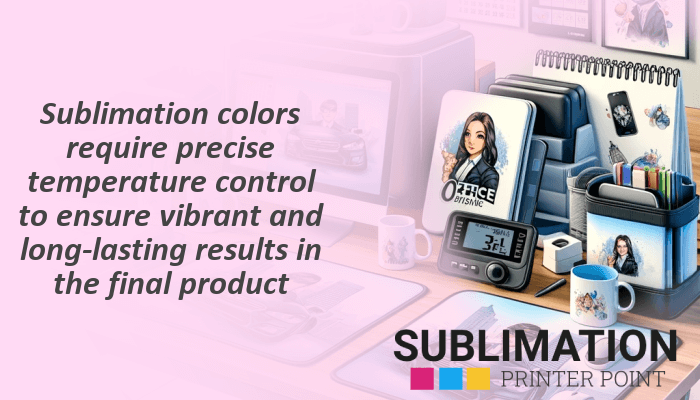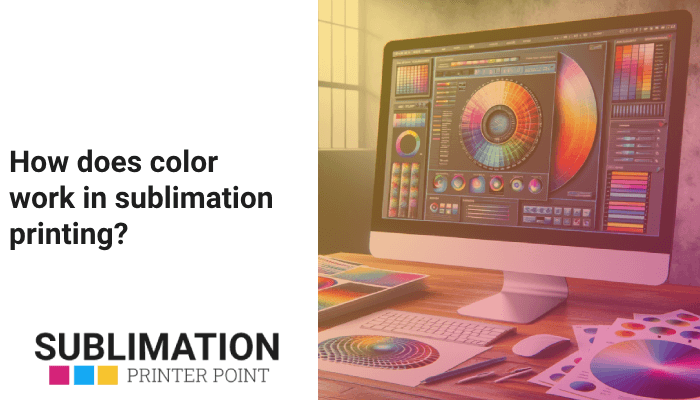In the world of sublimation printing, where color is king, prints are visually arresting and durable thanks to the complex dance of color, ink, heat, and fabric. This technique is evidence of the expressive power of color and how it can elevate ordinary materials to the level of artistic creation.
The dynamic process of sublimation printing relies on the interaction of cloth, heat, ink, and color. Color accuracy and vibrancy are vital, and premium sublimation ink is essential for achieving these results. Long-lasting prints are produced by the precisely calibrated heat transfer method, which guarantees that the colors penetrate the cloth. The fabric selection—polyester in particular—has a big influence on the final hue. High-quality prints are guaranteed by efficient color management techniques and accurate color reproduction provided by digital printing technology.
- Sublimation printing relies on the synergy of color, ink, heat, and fabric.
- High-quality sublimation ink is key to vibrant and accurate colors.
- Heat transfer process is crucial for color permeation and durability of prints.
- Polyester fabric is preferred due to its receptivity to sublimation ink.
- Digital printing technology enables precise color reproduction.
- Effective color management practices ensure high-quality prints.
What is the role of color in sublimation printing?
The dye-sublimation method relies heavily on color, which serves as the unifying factor throughout. It’s the color that gives designs life and turns them from abstract ideas into real, measurable things. The final product’s aesthetic appeal is significantly impacted by the vibrancy and accuracy of the colors used in sublimation ink. A print with the correct color scheme might be visually striking, but one with a bad color scheme will look drab. Thus, in order to get the best results from sublimation printing, it is essential to comprehend the subtleties of color.
How does sublimation ink contribute to color output?
The key component of sublimation printing is sublimation ink. It is the origin of the vivid colors that give the designs life when printed. The ink’s quality has a big impact on the color that is produced. Sublimation ink of the highest caliber, like Epson’s, guarantees an extensive color spectrum and exceptional color vibrancy. Furthermore, the ink’s sublimation—the process of changing from a solid to a gas without going through a liquid phase—means that the colors are infused into the fabric, producing designs that are durable and resistant to fading.
What is the importance of color profiles in sublimation printing?
In order to achieve color fidelity in sublimation printing, color profiles like those from the International Color Consortium (ICC) are essential. By acting as a link between the original images and the printer, these profiles guarantee that the colors seen on the screen are faithfully replicated on the printed material. To build a map that directs the color reproduction process, they consider the properties of the print medium, the sublimation ink, and the printer. In the absence of these profiles, the final print’s colors may differ dramatically from the original design, producing undesirable outcomes.
Always keep in mind that the type of cloth chosen might have a big impact on the color output when using sublimation printing. Polyester fabric works especially well for this procedure because of its synthetic fibers, which effectively absorb sublimation ink to produce vivid, long-lasting colors.
How does the CMYK color model apply to sublimation printing?
In sublimation printing, the industry standard color model is CMYK (Cyan, Magenta, Yellow, and Key/Black). According to this paradigm, every color is only a mixture of these four fundamental hues. After that, the printer uses these ratios of sublimation ink to reproduce the desired color. This type ensures high fidelity design reproduction by enabling the production of a wide variety of colors. It’s crucial to remember, too, that there are additional variables that affect color fidelity in addition to ink quality and heat transfer efficiency.
How does heat transfer affect color in sublimation printing?
An essential step in the sublimation printing process is heat transfer. It is the catalyst that causes the ink to sublimate and penetrate the fabric, allowing the colors to seep in. The heat transfer process’s time and temperature have a big impact on the color that results. The colors could become oversaturated if the heat is applied too high or the transfer time is too long. On the other hand, the colors could look washed out if the heat is set too low or the transfer period is too short. Thus, maintaining color accuracy and vibrancy requires striking the correct balance.
What is the impact of heat press on color fastness?
In order to guarantee color fastness in sublimation printing, the heat press is essential. The heat press is what makes the ink sublimate and embed the colors in the fabric. As a result, even after numerous washings, the prints won’t fade. To get this effect, the heat press must be utilized properly, though. Excessive heat might result in color bleeds, while insufficient heat can cause partial sublimation and fading prints. Thus, obtaining color fastness requires proficiency with the heat press.
How does heat transfer influence color management in sublimation printing?
One important aspect of color management in sublimation printing is heat transfer. The sublimation ink is activated by heat, which turns it from a solid into a gas and allows it to seep into the fabric. The heat transfer process’s duration and intensity can have a big impact on the color that results. Oversaturated colors can be produced by using excessive heat or a long transfer time, whereas dull, washed-out colors can be produced by applying inadequate heat or a short transfer time. Therefore, a complete grasp of the heat transfer process is necessary for successful color control.
It is essential to manage color in sublimation printing. The colors shown on the screen will be faithfully replicated on the print medium if color profiles such as ICC are used. Additionally, utilizing vector graphics (SVG, EPS, AI) can aid in preserving the color fidelity of the finished print.
What are the considerations for color in fabric printing?
Not all materials are made equal when it comes to fabric printing. The color output can be greatly influenced by the type of fabric used. For example, polyester cloth works especially well with sublimation printing. Bright, durable colors are produced because of how well the synthetic fibers in it absorb the sublimation ink. Conversely, natural textiles like cotton absorb the ink less well, which results in less vivid colors. As a result, selecting the appropriate cloth is essential to getting the best color results from sublimation printing.
Why is polyester fabric preferred for sublimation printing?
Because of its special qualities, polyester cloth is the recommended option for sublimation printing. Because of its synthetic fibers’ exceptional receptivity to sublimation ink, the colors can be deeply infused into the fabric. As a result, the prints are not only colorful but also stain- and washing-resistant. Furthermore, polyester fabric is resistant to damage from the high temperatures needed for the heat transfer procedure. Therefore, polyester cloth is the industry standard for sublimation printing.
How does fabric type affect color fastness in sublimation printing?
Color fastness in sublimation printing can be greatly impacted by the type of fabric used. Polyester and other synthetic materials absorb sublimation ink effectively, producing vivid, long-lasting colors in textiles used for this printing technique. On the other hand, natural materials like cotton absorb ink less well, producing less vivid colors that may smudge over time. Thus, in order to achieve color fastness in sublimation printing, selecting the appropriate fabric is essential.
How does digital printing technology influence color in sublimation printing?
Sublimation printing has seen a revolution because to digital printing technology, which provides previously unheard-of control over color reproduction. A large spectrum of colors can be precisely reproduced with digital sublimation printers. These printers apply the sublimation ink precisely in patterns and amounts using cutting-edge technology, producing colors that are exact and vivid. Additionally, vector pictures (SVG, EPS, and AI) can be used with digital printing technology since they can be resized without sacrificing quality, guaranteeing that the colors in the finished print accurately reflect the original design.
What is the role of sublimation printers in color reproduction?
In order to reproduce color accurately, sublimation printers are essential. These printers apply the sublimation ink precisely in patterns and amounts using cutting-edge technology, producing colors that are exact and vivid. A crucial element in the success of the sublimation printing process is the printers’ capacity to accurately reproduce a large spectrum of colors. As a result, purchasing a top-notch sublimation printer—like those made by Epson—is crucial to attaining exceptional color reproduction.
How does graphic design affect color output in sublimation printing?
In sublimation printing, graphic design has a big impact on the color output. The final print’s look is directly influenced by the colors used during the design phase. Selecting colors that will replicate accurately throughout the sublimation process is therefore essential. This entails being aware of the constraints of the CMYK color model in addition to the properties of the print medium and sublimation ink. Additionally, using vector files (SVG, EPS, AI) can assist guarantee that the final print’s colors accurately reflect the original design.
What are the best practices for color management in sublimation printing?
In sublimation printing, good color management is essential to producing prints of excellent quality. This calls for a variety of techniques, such as selecting the ideal cloth and sublimation ink and utilizing the proper heat transfer settings. Utilizing color profiles, like ICC, is also crucial to guaranteeing that the final print’s colors correspond with the original design. Furthermore, accurate color reproduction can be ensured by using vector pictures and a high-quality sublimation printer. Vibrant, realistic colors may be produced in sublimation printing by adhering to these best practices.

How to ensure print quality in terms of color in sublimation printing?
It takes multiple procedures to ensure color accuracy in sublimation printing. Using premium sublimation ink is crucial since it will have a direct impact on the final color output. Second, fabric selection is very important; polyester is the best material because it absorbs ink effectively. Third, to prevent color fading or oversaturation, the heat transfer process needs to be properly controlled. Lastly, you can help guarantee that the colors in the finished print are accurate to the original design by using color profiles and vector pictures.
What are the steps to achieve accurate color in sublimation transfer?
In sublimation transfer, there are several phases involved in achieving correct color. The design must first be made using a color model—such as CMYK—that is appropriate for the sublimation process. The design then needs to be produced using a printer that can faithfully reproduce the selected colors and premium sublimation ink. Then, using a heat press, the printed design is transferred to the fabric. The temperature and length of the transfer process are precisely regulated to guarantee color accuracy. Lastly, one should check the completed item to make sure the colors correspond to the original design.

